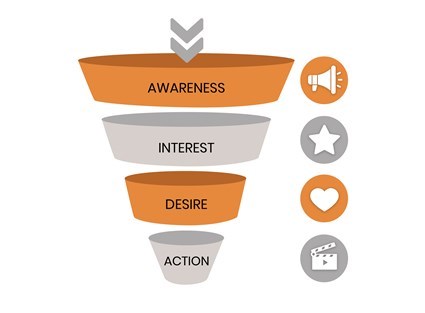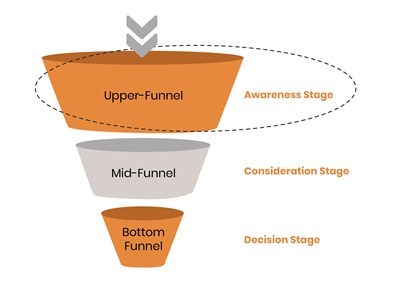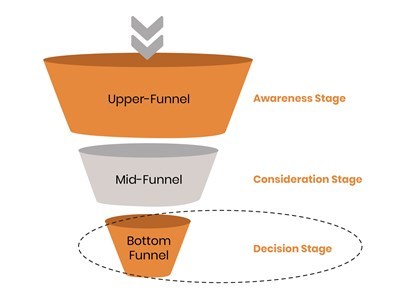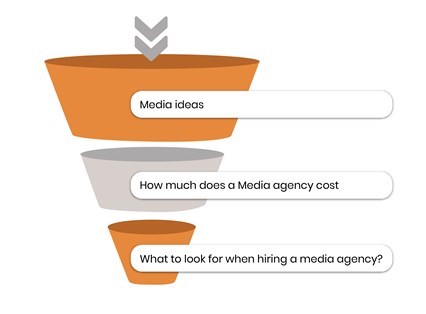Upper Funnel vs. Lower Funnel
Anyone who’s been in business for any extended period has likely heard about some variation of the sales funnel, the marketing funnel, or the conversion funnel. This funnel represents the entire customer journey, from the first awareness to the final act of making a purchase or converting in another way. Understanding the different elements of this funnel and how to apply the best marketing strategies in each piece is essential for businesses that want to see increased leads and conversions.
Typically, this funnel is divided into three main areas: upper, middle, and lower funnel marketing. Sometimes it may be broken down even further to include the various stages that take place in the buying journey. These stages include awareness, interest, desire, and action. Those who are still in the upper funnel will find themselves in the awareness and interest stages and require a different approach than leads who have reached the action stages of the consumer journey.
More extensive efforts should be focused on encouraging new leads to enter the funnel, along with those that guide action-oriented users in the lower part of the funnel to make final purchasing decisions. Having the most targeted marketing tactics for each part of the funnel will ensure the best lead generation and converting the most sales.
The Stages of the Funnel
Before you can get too far into optimizing upper- and lower-funnel marketing efforts, it’s important to understand the funnel and how it works.
A common conversion funnel typically has 4 individual stages or levels: awareness, interest, desire, action. From there, this is also broken out into 3 segments or portions: upper, middle, and lower.
Each section serves a different purpose and should be approached differently and with specific marketing techniques. This is why it is crucial to understand where your business or strategy falls within the funnel and at what stage.

Some marketing professionals will further break down this funnel or focus on the different areas more specifically, but generally, this is the standard marketing or sales funnel that businesses will use. Understanding this tool makes all the difference in being able to optimize marketing efforts.
Those who go further than these four stages might consider stages like:
Upper Funnel
- Awareness
- Interest
- Consideration
Middle Funnel
- Evaluation
- Decision
Lower Funnel
- Purchase
- Repeat Business
- Loyalty/Advocacy
The conversion funnel can be broken down as much as you want to help ensure that your marketing strategies are on point. However, it’s not recommended to micro-classify every single group of users because that can create its own problems. This is why most stick to the basic four stages and go from there.
This guide will outline the differences between upper and lower funnel, what they entail, and how to create solid marketing strategies for each stage of the buying journey for consumers.
What is Upper Funnel?
The upper funnel is the beginning of the consumer journey, or where leads first come in. This is the stage where users are just starting their research, trying to find information on products or services needed or desired. There is usually a lot of research at this phase, including investigating different brands and what they have to offer.

The upper funnel usually encompasses the awareness stage, although some would include the interest stage in upper funnel marketing to help draw more users toward the lower stages of desire and action. Keep in mind that all of the stages have the main goal to drive customers to conversions, by focusing on a specific action or purpose.
In this case, the purpose would be to attract new visitors and get them interested in what there is to offer. That will ultimately lead them down the funnel and closer to conversions, simply because the right demographic is being targeted with marketing efforts.
Being able to target this specific group of people will help to create a more effective strategy for generating leads and getting potential consumers into the funnel in the first place. This is possibly the most critical step in the funnel because potential consumers have the tendency to turn toward the business most effective at capturing their attention.
Upper funnel advertising and marketing should be designed to reach users before they’ve begun to be aware of your brand or product specifically.
Display ads, video ads, and other marketing tools can be used in this area, but the most effective options are things like SEO and local optimization (for local businesses). The standard strategies for marketing and attracting new clients include:
- Consumer research
- Creating buyer personas
- Starting new marketing campaigns
- Attending in-person events
- Creating advertising content
- Promoting existing content
- Using paid ads to increase brand awareness
What is Lower Funnel?
The lower funnel is where people have already started looking for specific brands. In this case, if they’re in your funnel, they’ve decided that this product or service may be worth their time and money. They are researching and finding all the information they need to make a purchase, so marketing efforts must be geared toward that goal.
There are several tools and marketing strategies that can be used, but long-tail keywords and remarketing are the most effective.

People in the lower funnel are usually close to the action stage, meaning, they’re about ready to make a purchase. They just need that one little push to choose your brand. That’s why lower funnel optimization includes things like creating smaller, different conversion funnels for that final conversion that are tailored to the people within the funnel.
This is also a place where customer data can help provide the best targeted experiences for users, while also keeping them engaged, making them want more from your brand. It’s also important to note that this isn’t the “end” of the customer lifetime experience, just this specific journey.
Once people have converted, you can pull them back to the middle funnel stages and nurturing phase to continue getting their business with remarketing. Email campaigns and targeted offers are most important at this level of the funnel, as are those personal connections that today’s consumers crave.
One of the biggest concerns in the lower funnel is cart abandonment. This term refers specifically to eCommerce, but it can include anyone who navigates away from a business or website right before they’re about to complete a transaction or convert to a customer. This is where you need to remind people of their carts, they’ve chosen your brand, and notify them of price drops, special offers, or other deals to ensure they complete the transaction.
In the lower funnel, the efforts will be more focused and direct, designed to reach people and provide them with specific information and marketing insights so that they can make an ultimate purchase decision. Use strategies and tactics like:
- Targeted email marketing
- Free trials or discount offers
- Surveys
- Detailed explanations of services or products
- Presenting specific products or highlighting services based on interests
- Providing reviews and testimonials that convince buyers to make the final conversion
Do I Need to Consider Both Strategies?
Absolutely.
Those who are new to marketing errantly assume that they may not need both upper-funnel and lower-funnel strategies in place, however that couldn’t be further from the truth. While the middle of the funnel is usually left for those who are trying to sort out their next moves, the upper and lower parts of the funnel are the most valuable pieces of this funnel. Without taking the time to create marketing strategies for the upper funnel that attract leads and business, there will be no customers in the middle or lower parts of funnel to continue the buying journey.
Today, there are a growing number of companies competing for the same audiences online, which means standing out to consumers with the correct marketing strategies is crucial.
Part of that comes in embracing and implementing the right marketing tactics and strategies, including upper and lower-funnel marketing efforts. Dividing the customer journey or conversion funnel into stages will allow space to focus on target audiences at each step of the buying journey so that the best results are delivered and the most effective marketing strategies to get people moving through the funnel toward a conversion is utilized.
However, the marketing funnel is not a new concept. It works as an entire piece, but it is also the sum of its parts. If not enough time and effort is spent on the various parts of the marketing funnel, it will be difficult to keep up with the competition or attract the type of business necessary to succeed. Focusing on delivering tactics and strategies that fit the different stages of the buying process can also produce positive results.
Visualization is a crucial part of the funnel concept. It’s important to visualize a customer’s journey from start to finish to understand how to approach each touchpoint along the way.
Who Should Be Responsible for the Upper Funnel and Lower Funnel Strategies?
This is a necessary question for businesses today: who should be responsible for all the different marketing efforts? Ideally, a business will have a marketing team that can be divided into different groups, however the marketing manager will need to oversee these strategies and their execution. For businesses that are looking to maximize the skills of their employees, upper-funnel marketing should be left to those who are good at attracting leads.
On the other hand, lower funnel marketing strategies should be executed and managed by those who are good at closing the deal, for the best chances of a conversion.
For businesses, members of the marketing team are responsible for nurturing upper funnel leads, while sales experts will be the best fit to focus on the lower funnel and nurture those leads to a conversion. However, this will ultimately depend on the management of strategies for a business.
It is necessary for these strategies to be incorporated in the overall marketing strategy to ensure that the entire team can deliver the best experience and most consistent buying journey for users as they come to your business. It is necessary for whoever oversees the marketing department to be aware of and manage these strategies to ensure proper execution to deliver the desired results for your business.
Some companies choose to outsource their upper and lower-funnel marketing strategies, along with the rest of their marketing efforts. You can do this by hiring a team of marketing professionals that are experienced with all stages of the conversion funnel from start to finish. They will manage and ensure the marketing strategies are implemented effectively, as well as collaborate with you with the intention of finding the best results and understanding each stage of this process as it happens.
There’s no real cut-and-dry answer to who should oversee each of these stages of marketing. It’s more important to create a comprehensive marketing strategy to manage the different elements, including the upper and lower funnel efforts that you put in place, and optimizing them for your audience.
Optimizing the Upper and Lower Funnel
Once each individual part of the funnel is understood, it will be more useful when implementing an optimization strategy to drive overall success for conversion and sales.
It’s important to try different tactics to recognize what works best for your business and efficiently implement marketing strategies, based on the position in the funnel and the exact buying stage that potential consumers are at. That’s why it needs to be broken down in your marketing strategy to make sure that you optimize each stage for the right audience.
Upper Funnel Optimization
The upper funnel begins with traffic that comes into a business. That traffic will determine how effective the conversion journey will be. If a business is bringing in traffic that has no interest in what there is to offer, you’re losing before you start. The first and most important step here is to define and focus on driving quality traffic and leads to the website.
This is where keyword optimization will be beneficial, this tool can be used to drive better traffic with display ads and paid search ads. Keyword optimization will ensure that the correct consumers are finding your site when they search for similar keywords. If not familiar with SEO and other optimization efforts, outsourcing to a third-party provider can simplify optimization process.

Another part of optimizing the upper funnel is to recalibrate and optimize social media ads and interactions. Today’s consumers spend a great deal of time on social media and often expect the brands to be available there, as well. If your social media pages and ads aren’t optimized, people won’t be able to find you.
Social media marketing also includes things like sharing content, building relationships, and working to create a reputation of authority for your brand. This will ensure quality leads are being generated from reliable sources. People searching for a specific business and are unable to find it on social media may go elsewhere, so this step is crucial.
The final step in optimization for the upper funnel is to create unique content that utilizes a list of keywords and helps a business build authority within your industry.
All kinds of content can be created, depending on the demographic that is trying to be reached:
- Blog posts
- Articles
- eBooks
- Videos
- Infographics
- Guides
- Whitepapers
It is imperative to ensure quality content is being offered, first and foremost. Adding keywords to a blog or website page isn’t enough for keyword optimization. It takes a well thought out strategy that includes keyword research, utilization, and content creation. You can start small with content creation and build a strategy that becomes more robust as time goes on.
Lower Funnel Optimization
At the lower-funnel stage of the buying journey, consumers are already familiar with their options. They know what they are looking for and they feel like they’ve found the best resources for it. Now, it is essential to convince them they’re correct and should choose your business. Moving down the funnel away from the awareness stage to the lower funnel it would be a great loss for the consumer to choose a competitor. That’s why some companies consider lower funnel marketing to be even more valuable than the upper funnel. The lower funnel provides the opportunity now to build loyalty and turn one-time visitors into lifelong customers.
How is this possible? The lower funnel optimization efforts that are chosen will depend on the audiences that are trying to be reached. This is where customer data can be utilized. Using analytics and reporting tools, you will be able to deliver targeted, personalized experiences so that the people at this stage remain interested and come back for more.
Once a consumer gets to the lower funnel, it’s important to then begin the remarketing funnel—a conversion in the lower funnel could be any of the following:
- A sale
- A social media follow
- An email signup
- A completed contact form
- Scheduling a demo
- Visiting a certain site or page
- A free trial
- A subscription renewal
- A repeat sale
It’s important to keep in mind what conversion expected in lower funnel marketing, making it easier to enlist the most effective strategies to achieve those goals.
With lower funnel marketing, you’re ultimately trying to reduce people’s anxieties or doubts, and increase their confidence and trust in a product and company, providing them with the final reassurance needed to make a purchasing decision. Providing educational resources to people will give them the confidence to decide (ultimately the decision that your product or service is the best).
This can be done through marketing efforts like:
- Webinars
- Facebook or YouTube Live Q&A sessions
- Video walkthroughs
- Limited trial accounts
- Case studies
- Reviews and testimonials
- Authoritative content
How Do I Determine How Much of Each I Need?
This is another answer that depends entirely on the type of business and what goal is to be achieved. Ultimately, implementing strong marketing and conversion strategies at every level of the funnel is ideal. Much of this is knowing how much effort to place on each part of the process. That will depend on several factors that are unique to each business.
Goals
Goals within each step of the marketing funnel will determine how much effort is needed to put into each stage or strategy created.
For example, if you have a solid upper funnel strategy already in place, focus on the lower funnel efforts could be more beneficial as well as setting unique goals for each part of the funnel. That will help determine how much effort to put in and where.
Brand Awareness
What’s the brand awareness like? Is your brand already well-known or is it not as popular? If there isn’t as much brand awareness as others, focus may be necessary on the upper funnel where leads are obtained in the first place.
Awareness is essential to getting potential consumers into the funnel. If there is already a solid level of brand awareness, there may not be as much of a need for focus on upper-funnel marketing, depending on unique circumstances.
Competition
What’s the competition like? The more competition, the harder work must be put in to get the attention of users at the upper and lower ends of the funnel. It’s also important to implement strategies that help you stand above the competition.
This can also be a place to see what the competition is doing and mirror their efforts, when successful. It’s also a way to see what competitors are doing that doesn’t work so that you can skip those strategies in the funnel marketing.
Measuring Upper and Lower Funnel Marketing Efforts
Once strategies are in place, it is crucial to measure their success and ensure that they are delivering. Stay on top of the marketing funnel by monitoring new users, bounce rates, new social media follows, and so forth—looking for metrics that show people’s first interactions with the brand.
At the lower end of the funnel, measure important information such as sales, repeat purchases, order value, and customer lifetime value. This will help ensure that marketing efforts are getting the conversions desired. If changes need to be made, the metrics will serve as a guide.
The Bottom Line
Clearly, when it comes to properly implementing upper- and lower-funnel marketing efforts and making sure that they are properly monitored and managed for effectiveness is a long and thorough process. Each stage in the funnel has its own marketing tactics and customer concerns to consider, emphasizing the importance of overall marketing strategy including detailed sub-strategies for upper- and lower-funnel marketing.
While the middle of the funnel is important, most efforts in sales and marketing strategies will come from the top of the funnel where you attract business, and the bottom of the funnel leading to conversions. Understanding what each includes and how to optimize them effectively will make all the difference in driving success.
